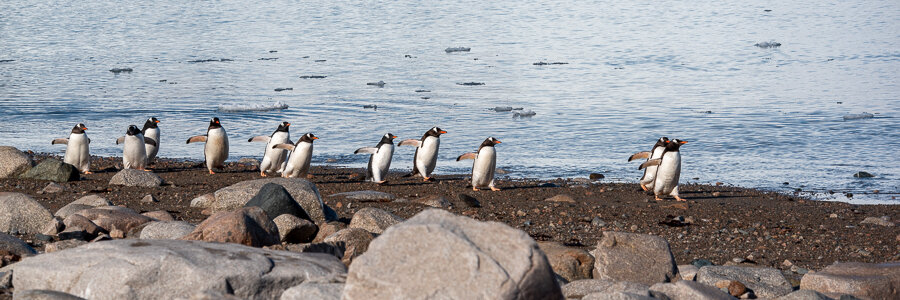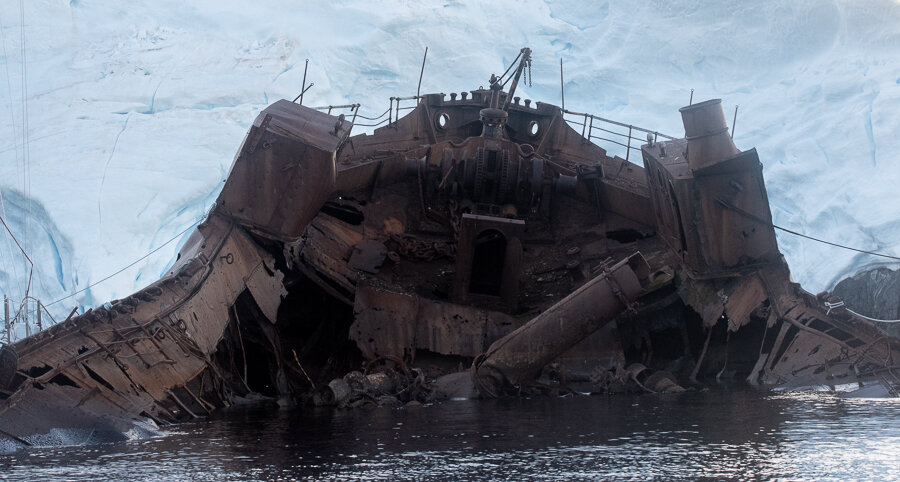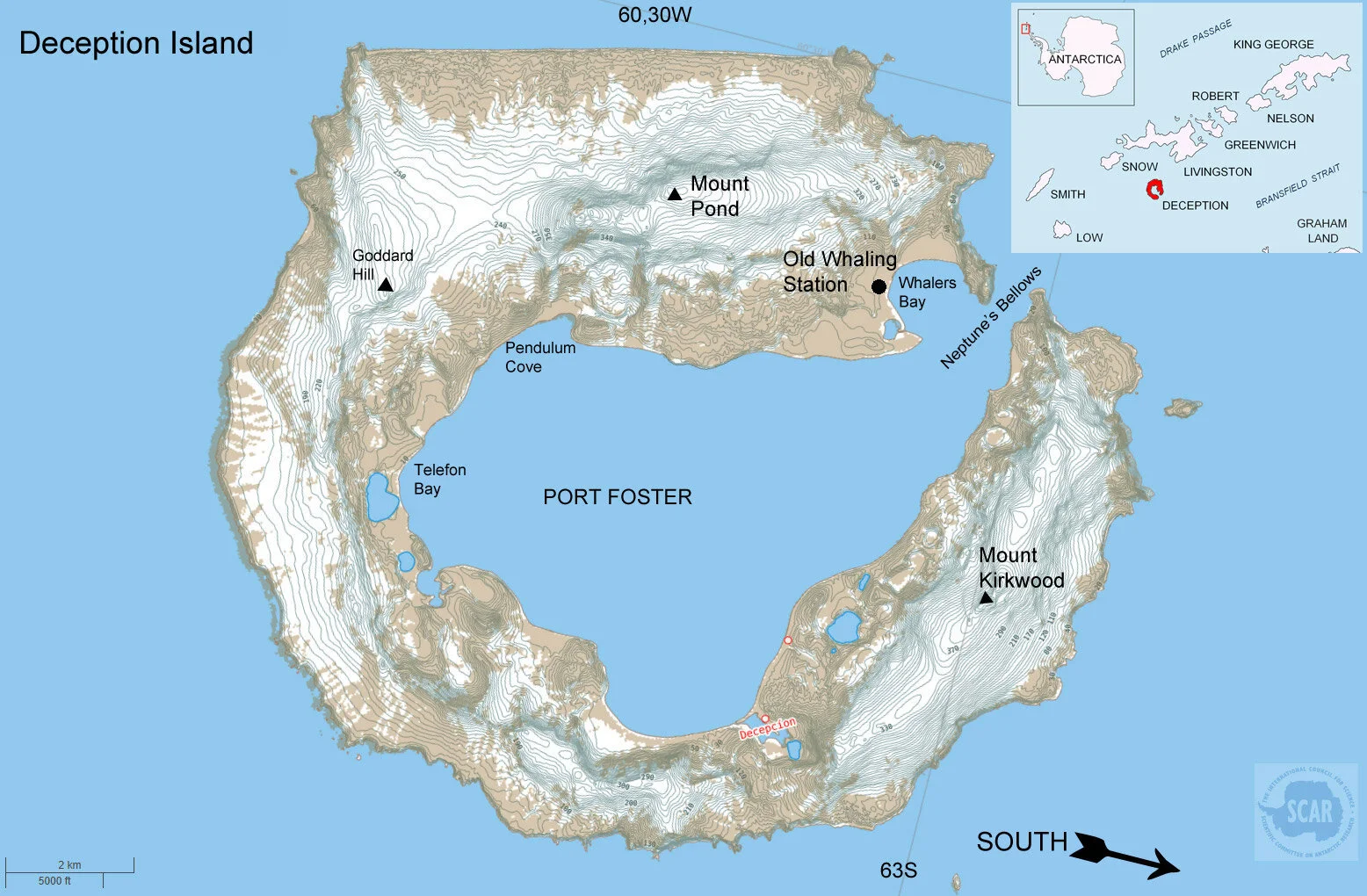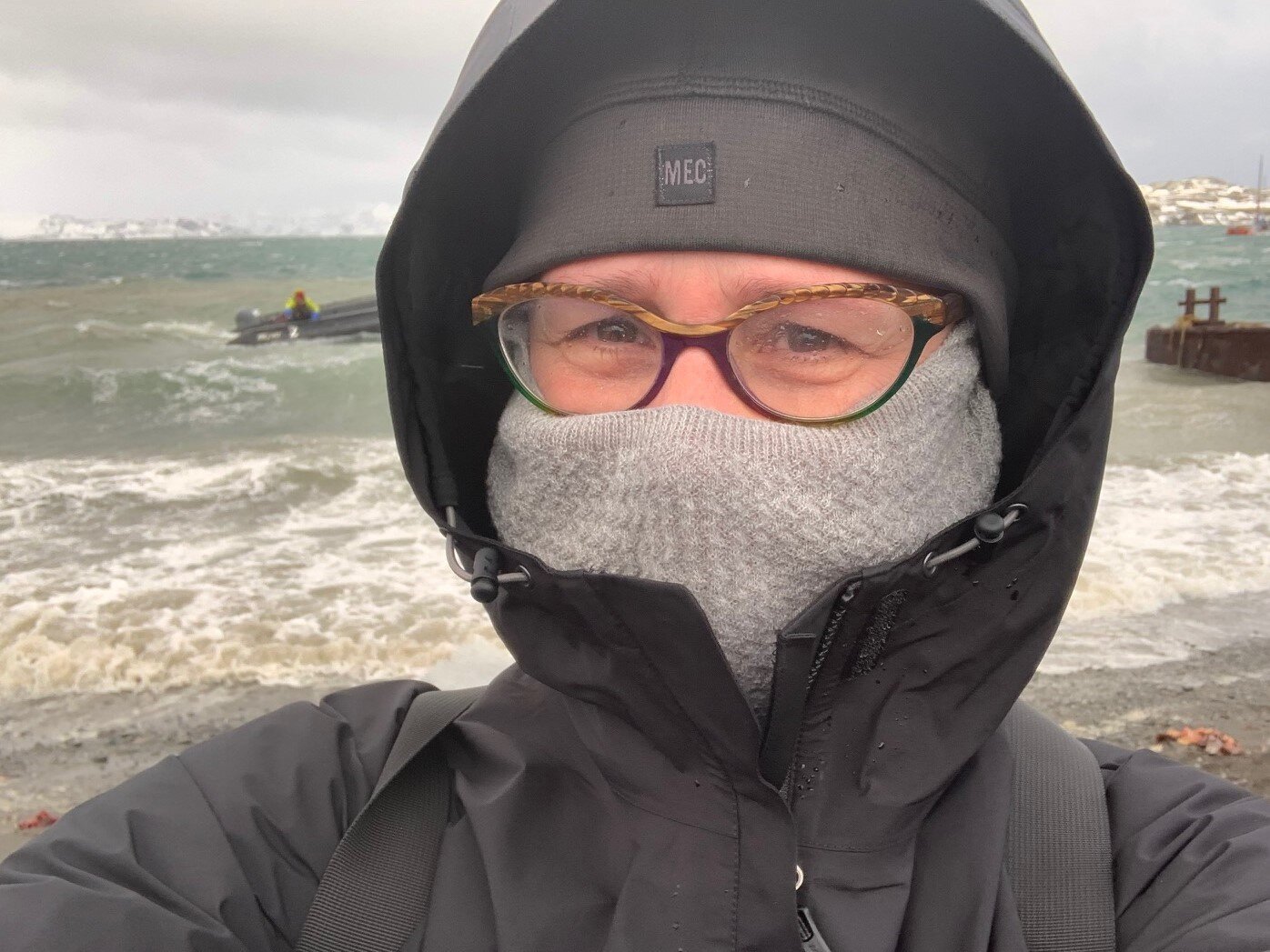February 22 – Day 6
We arrived in Neko Harbour on the morning of our sixth day to bright blue skies, still water and absolutely gorgeous reflections. As soon as we were anchored, we unloaded the zodiacs and prepared for an excursion.
I thought I should post at least one shot of my room (or at least my side of the room). I used the top bunk to lay out clothes and equipment so I could get out onto the deck quickly to photograph if need be.
This pictures was taken in the evening, after turn down service (note the chocolate on the pillow!). The Ocean Nova is an expedition ship, not one of the fancy, new, luxury ships, but the staff took amazing care of us.
This is the embarkation platform. For an excursion, each zodiac is lowered, the driver boards, and then they wait on the water until all the other zodiacs are launched. Then they come in one at a time to pick up passengers.
Every time the zodiacs had to be loaded or unloaded, this was the process:
As the expedition crew were launching zodiacs, two Minke whales were playfully circling the ship and the zodiacs. While we were on shore, we could hear them blowing in the bay. In Neko Harbour, instead of going out with the workshop group to photograph icebergs (this bright, harsh light isn’t the light that I really like) I went on shore to visit a Gentoo penguin rookery. Before going on shore, we were given careful instructions as to how to behave: we were told not to interfere with the penguins in any way – not to approach too closely to them and not to stand on the penguin highways (they are obvious from the repeated penguin footprints) so as not to block them or, in creating deep footprints into the mud or snow, making them impassible for the penguins on their short legs. All the wildlife we saw in Antarctica were completely unafraid of people, a wonderful testament to the fact that for 60 years, they have been protected.
After I’d explored around the rookery, I chose to sit on a nice flat-ish rock alongside a penguin highway, just waiting for penguins to come by (see the video below). I spent the rest of our visit quietly observing and photographing the penguins as they went about their business and just enjoying the sunshine and being in that amazingly beautiful place.
Gentoo penguins, Neko Harbour.
Gentoo penguin.
No one knows quite why penguins (including Gentoos) swallow stones, but I saw this one doing it. One theory is that it may be to a way of counteracting buoyancy.
While we were at the rookery, we could hear the cracking of the glacier and see waterfalls of snow falling down from the mountainside on two occasions. I had read that the area around Neko Harbour is prone to flooding, as chunks of ice commonly fall off the ice cliffs and into the water, but we were lucky that did not happen while we were there.
After sitting for a while with the penguins, I took a zodiac trip through the harbour, looking for the Minke whales who had been around the ship early in the morning. We didn’t find any but at one point we turned off the engine to enjoy the place in peace and quiet. It was beautiful: bright sunshine, beautiful reflections and silence.
It’ll be hard to see in this picture, but as we returned to the ship they were cleaning the windows. You can see one of the men in the zodiac with his long pole and squeegee. They did this every day they were able to make sure we always had good views.
After lunch, we left Neko Harbour and set sail for Enterprise Island. I took a few minutes before lunch to sit in the library with its wall of windows at the stern of the ship to watch as we left Neko Harbour. I was thinking, “Maybe they need a librarian to work on this ship. If so, I should apply!” : )
In the afternoon we took a zodiac cruise through Wilhelmina Bay (around Enterprise Island). The sun was bright, but I shot detail images of icebergs. We made our way to the wreck of the whaling factory ship Guvernøren in Foyn Harbour, which was a pretty dramatic sight. Two yachts travelling through Antarctic were moored to it. I sure wouldn’t have wanted to cross the Drake Passage in either one of them!
Lone Gentoo on an iceberg in Wilhelmina Bay
Iceberg details in the sunlight.
The wreck of the whaling factory ship Guvernøren in Foyn Harbour,.
February 23 – Day 7
We did an overnight crossing of the Bransfield Strait, with high winds and rougher seas than we’d experienced thus far, making for a bouncy night but, surprisingly, I was fine. We arrived the next morning at Neptune's Bellows, the entrance to Deception Island, to driving wind and snow. The island is called Deception because from the sea it looks like a normal island, but once you cross through Neptune’s Bellows, you can see that is actually a caldera. The volcano underneath is still active and it erupted most recently in 1970.
As soon as we came to anchor, we took zodiacs from the ship to Whalers Bay. In the early 20th century, factory ships (so-called because whales were processed on board the ships) were anchored all around this protected bay. A permanent on-shore processing facility was built in 1908 and the rusted remains of buildings and storage tanks can be seen there still. There are also buildings belonging to the British Antarctic Survey base which was evacuated in 1967 during an eruption of the volcano. The base was eventually abandoned after another eruption in 1969.
These were storage tanks for oil produced by whaling operations. You can see the size of them from the figure standing to the left.
Remains of the early 20th-century whaling station
When we arrived on shore at about 9:15am, we were told that the last zodiac would return to the ship at 11:30. I didn't think I would stay that long because it was windy, with a rain/snow mix, and I had to shoot-wipe the lens-shoot-wipe the lens as I photographed. The scenes on the island, though, were so wonderful and compelling that I was one of the last people to leave. I went down to the beach at 11:30 when only 3 passengers remained on shore – the other two were picked up but another zodiac further along the beach - and I rode back with the expedition crew. In a really nice touch, when we arrived back at the ship after a wet and cold morning, the kitchen staff were waiting for us with hot chocolates for everyone.
Zodiacs waiting for the last passengers on Deception Island. The beach is geothermally heated, so at low tide, clouds of steam rise from the shore. It is possible to go swimming here, but I didn’t try it!
Hitching a ride home with the expedition crew on the last zodiac.
On the bridge. A future career for me with my new-found sea legs? : )
The wind was really up by the time we got back to the ship - steady at 40 knots, gusting to 50 knots. It was a bit tough eating lunch – definitely a ‘hold your plate’ kind of meal.
That evening we got some big swells (up to seven metres, the first officer told me) and the ship was really moving. Unlike some other ships, on the Ocean Nova you can go up to the bridge anytime you want. The crew are very welcoming and are happy to answer any questions, of which, of course, I had many. I visited three or four times during the voyage and, surprisingly, the first officer told me I was one of the few passengers to do so.
That evening, I spent about an hour watching the waves which were big enough to crash over the bow and onto the windows of the bridge (on the 4th level of the ship!), which was pretty exciting.
At dinner, though, the dining room was about 1/3rd empty, with a number of people down with seasickness.
Below are a couple of videos of the rough seas from the bridge. I don’t know that they really capture how it felt, but they will give you an idea.
February 24 – Day 8
We woke on our last day to see we had arrived at King George Island during the night. The island was covered in a dusting of snow, new since we were last there, over a week before. Ours was the Ocean Nova’s last trip south of the Antarctic Circle for the season. Though the Antarctic summer season lasts right until the end of March, it’s clear that winter was coming to the continent as our trip was ending.
Every morning of the trip at 6:30am freshly-made pastries were laid out in the Panorama Lounge at the bow of the ship. On this last morning I was up early and headed up there to grab a cinnamon bun and have a last look at Antarctica. There were a few people up there already. Everyone was quietly staring out the windows and there was a sense that we all wished the trip wasn’t almost over.
With snow falling, low clouds and a driving wind, the plane from Punta Arenas was not be able to arrive until late afternoon, though we were originally scheduled to leave in the morning. We waited on the ship until we were finally able to disembark.
The weather was messy: the wind was high and the seas were rough which made the zodiac landing at King George Island a challenge for the crew (and for us). When we hit the beach we were greeting by expedition crew members in full dry suits who held the zodiacs in place and helped people on to shore. I was at the back of our zodiac and was doused twice with big waves as we landed and I waited for my chance to get off. Ten minutes after I hit the beach, I realized I still had a pocket full of salt water in my jacket! My camera gear was all OK, and even though my duffel bag was drenched in salt water, nothing important was damaged. It was a fitting and exciting end to the trip.
After a windy 1.5 kilometre walk up to the landing strip to wait for the plane, we boarded and headed back to Chile. By 11:30pm, we were at the hotel in Punta Arenas and I’m sure everyone, like me, just collapsed into bed.
February 25
The wreck of the Lord Lonsdale outside Punta Arenas.
Just as I had at the beginning, I scheduled an extra day in Punta Arenas in case we got stuck on the continent due to bad weather. I spent the day doing some long exposure shots of the piers I scouted the week before, as well as photographing some of the shipwrecks outside of town.
Then, the next day, all that was left was the 24+ hour journey home and, luckily a few days for recovery before going back to work.
What an incredible trip this was! I have joked that this was a trip of a lifetime because I can never afford to come back again, but there was something truly profound and unique about this experience which could never be repeated, I think, even if I am lucky enough to get back. The trip itself was fantastic – Antarctica XXI is a wonderful operator and Seth and JP always got us into position for the best photography. For me, the light was often the kind I like and we regularly had some dramatic clouds on the top of the mountains in the beautiful scenes around us. There were moments of awe – that morning in the Fish Islands, alone on deck, or being the last on deck in the Lemaire Channel because the light was so gorgeous, being investigated by a curious leopard seal in Pléneau Bay and even those somewhat (not Drake-standard, but still big to me) rough seas at the end of the trip. Those were moments of joy and awe. What I will most remember, though, is the sense that I was a short-term (very short-term) guest in that place. Antarctica is truly a wild place. I have been to Africa, I have been to the Arctic, I have been to remote parts of the jungles of New Guinea and I have never been to a more wild place in my life: a place where humans are truly the guests. Most of the continent is so remote, so difficult to access, and so cold that it defies human control. Our actions, though, and the resulting change to the climate that is being created by them, will affect the whole continent. I only hope that we can make the changes we need to make to preserve this beautiful and remote place in its unspoiled state. It was an incredibly privilege to visit, even if too briefly, this pristine, awe-inspiring, wild place.
If you’d like, you can take a look at the short Antarctica video I created.
You can see the images from this amazing trip in my Antarctica gallery.
This is the full route we took. Happy memories at every one of those spots.
A selfie from King George Island, just after we landed: wet, exhilarated and sad that it was all over.





















